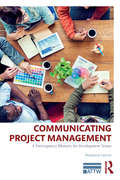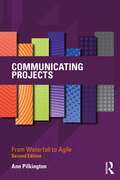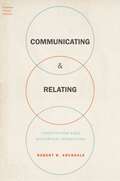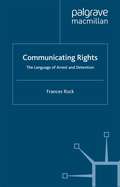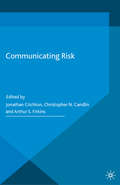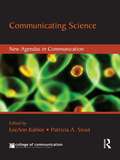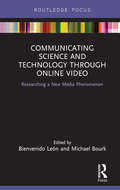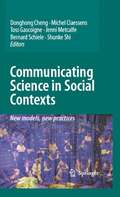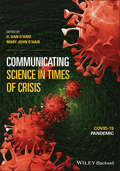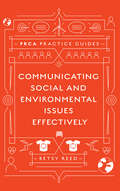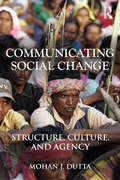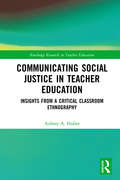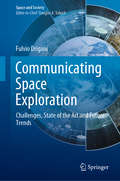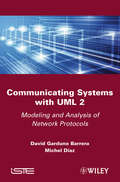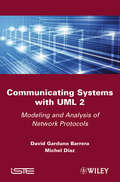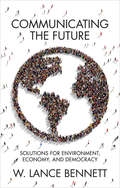- Table View
- List View
Communicating Project Management: A Participatory Rhetoric for Development Teams (ATTW Series in Technical and Professional Communication)
by Benjamin LaurenCommunicating Project Management argues that the communication practices of project managers have necessarily become participatory, made up of complex strategies and processes solidly grounded in rhetorical concepts. The book draws on case studies across organizational contexts and combines individual experiences to investigate how project management relies on communication as teams develop products, services, and internal processes. The case studies also provide examples of how project managers can be understood and studied as writers, further arguing project managers must approach communication as designed experience that must be intentionally inclusive. Author Benjamin Lauren illustrates to readers how teams work together to manage projects through complex coordinative communication practices, and highlights how project managers are constantly learning and evolving by analyzing where they succeed and fail. He concludes that technical and professional communicators have a pivotal role in supporting and facilitating participative approaches to communicating project management.
Communicating Project Management: A Participatory Rhetoric for Development Teams (ATTW Series in Technical and Professional Communication)
by Benjamin LaurenCommunicating Project Management argues that the communication practices of project managers have necessarily become participatory, made up of complex strategies and processes solidly grounded in rhetorical concepts. The book draws on case studies across organizational contexts and combines individual experiences to investigate how project management relies on communication as teams develop products, services, and internal processes. The case studies also provide examples of how project managers can be understood and studied as writers, further arguing project managers must approach communication as designed experience that must be intentionally inclusive. Author Benjamin Lauren illustrates to readers how teams work together to manage projects through complex coordinative communication practices, and highlights how project managers are constantly learning and evolving by analyzing where they succeed and fail. He concludes that technical and professional communicators have a pivotal role in supporting and facilitating participative approaches to communicating project management.
Communicating Projects: From Waterfall to Agile
by Ann PilkingtonThe communication of projects to each stakeholder group is essential to their success. This book is an end-to-end guide for project managers and communication teams seeking to communicate effectively with all constituents, both internal and external. This new edition includes a number of key topical themes that build on the first edition: An introduction to project management for those new to the field, including communicating "agile", as many communication practitioners and project managers find themselves having to communicate in an agile environment, which has a language all of its own. The important role of social media and enterprise social networks as vital communication channels. The principles of change management. The role of storytelling and the importance of translating technical terminology and data into stories that clients and the wider stakeholder groups understand. Crisis communication – ensuring there is a crisis or emergency communication process in place in case it is ever needed. This highly practical book is invaluable reading for communication professionals who are increasingly managing the communication elements of projects. It also supports project managers who need to gain a practical understanding of how to design and deliver communication, as well as helping them to procure effective communication support.
Communicating Projects: From Waterfall to Agile
by Ann PilkingtonThe communication of projects to each stakeholder group is essential to their success. This book is an end-to-end guide for project managers and communication teams seeking to communicate effectively with all constituents, both internal and external. This new edition includes a number of key topical themes that build on the first edition: An introduction to project management for those new to the field, including communicating "agile", as many communication practitioners and project managers find themselves having to communicate in an agile environment, which has a language all of its own. The important role of social media and enterprise social networks as vital communication channels. The principles of change management. The role of storytelling and the importance of translating technical terminology and data into stories that clients and the wider stakeholder groups understand. Crisis communication – ensuring there is a crisis or emergency communication process in place in case it is ever needed. This highly practical book is invaluable reading for communication professionals who are increasingly managing the communication elements of projects. It also supports project managers who need to gain a practical understanding of how to design and deliver communication, as well as helping them to procure effective communication support.
Communicating & Relating: Constituting Face in Everyday Interacting (Foundations of Human Interaction)
by Robert B. ArundaleCommunicating & Relating offers an account of how relating with one another emerges in communicating in everyday interacting. Prior work has indicated that human relationships arise in human communicating, and some studies have made arguments for why that is the case. Communicating & Relating moves beyond this work to offer an account of how both relating and face emerge in everyday talk and conduct: what comprises human communicating, what defines human social systems, how the social and the individual are linked in human life, and what comprises human relating and face. Part 1 develops the Conjoint Co-constituting Model of Communicating to address the question "How do participants constitute turns, actions, and meanings in everyday interacting?" Part 2 argues that the processes of constituting what is known cross-culturally as "face" are the processes of constituting relating, and develops Face Constituting Theory to address the question "How do participants constitute relating in everyday interacting?" The answers to both questions are grounded in evidence from everyday talk and conduct. Like other volumes in the Foundations of Human Interaction series, Communicating & Relating offers new perspectives and new research on communicative interaction and on human relationships as key elements of human sociality.
Communicating & Relating: Constituting Face in Everyday Interacting (Foundations of Human Interaction)
by Robert B. ArundaleCommunicating & Relating offers an account of how relating with one another emerges in communicating in everyday interacting. Prior work has indicated that human relationships arise in human communicating, and some studies have made arguments for why that is the case. Communicating & Relating moves beyond this work to offer an account of how both relating and face emerge in everyday talk and conduct: what comprises human communicating, what defines human social systems, how the social and the individual are linked in human life, and what comprises human relating and face. Part 1 develops the Conjoint Co-constituting Model of Communicating to address the question "How do participants constitute turns, actions, and meanings in everyday interacting?" Part 2 argues that the processes of constituting what is known cross-culturally as "face" are the processes of constituting relating, and develops Face Constituting Theory to address the question "How do participants constitute relating in everyday interacting?" The answers to both questions are grounded in evidence from everyday talk and conduct. Like other volumes in the Foundations of Human Interaction series, Communicating & Relating offers new perspectives and new research on communicative interaction and on human relationships as key elements of human sociality.
Communicating Rights: The Language of Arrest and Detention
by F. RockOrganizations acting on behalf of society are expected to act fairly, explaining themselves and their procedures. For the police, explanation is routine and repetitive. It's also very powerful. This book provides an unusual opportunity to see different speakers and writers explaining the same texts in their own words in British police stations.
Communicating Risk (Communicating in Professions and Organizations)
by Steven BerbecWe live in world increasingly shaped by risk, a fact underscored by recent events in the financial markets, science and technology, environmental policy and biosecurity, law enforcement and criminal justice. Risk assessment has become a central concern of governments, organisations and the professions, and the communication of risk is a crucial part of professional work. Exploring how risk is discursively constructed across these domains is therefore central to our understanding of how professional practice affects people's lives. Communicating Risk takes up this challenge, with contributions from leading researchers and practitioners that examine key issues of risk communication across diverse professional domains.
Communicating Science: New Agendas in Communication (New Agendas in Communication Series)
by LeeAnn Kahlor Patricia StoutThis volume explores the evolution of science communication, addressing key issues and offering substance for future study. Harnessing the energies of junior scholars on the forefront of science communication, this work pushes the boundaries of research forward, allowing scholars to sample the multiple paradigms and agendas that will play a role in shaping the future of science communication. Editors LeeAnn Kahlor and Patricia Stout challenge their readers to channel the energy within these chapters to build or continue to build their own research agendas as all scholars work together – across disciplines – to address questions of public understanding of science and communicating science. These chapters are intended to inspire still more research questions, to help aspiring science communication scholars locate their own creative and original research programs, and to help veteran science communication scholars expand their existing programs such that they can more actively build interdisciplinary bridges. Crossing methodological boundaries, work from quantitative and qualitative scholars, social scientists and rhetoricians is represented here. This volume is developed for practitioners and scholars alike – for anyone who is concerned about or interested in the future of science and how communication is shaping and will continue to shape that future. In its progressive pursuit of interdisciplinary research streams – of thinking outside methodological and theoretical boxes – this book inspires science communication scholars at all levels to set a new standard for collaboration not just for science communication, but for communication research in general.
Communicating Science: New Agendas in Communication (New Agendas in Communication Series)
by LeeAnn Kahlor Patricia StoutThis volume explores the evolution of science communication, addressing key issues and offering substance for future study. Harnessing the energies of junior scholars on the forefront of science communication, this work pushes the boundaries of research forward, allowing scholars to sample the multiple paradigms and agendas that will play a role in shaping the future of science communication. Editors LeeAnn Kahlor and Patricia Stout challenge their readers to channel the energy within these chapters to build or continue to build their own research agendas as all scholars work together – across disciplines – to address questions of public understanding of science and communicating science. These chapters are intended to inspire still more research questions, to help aspiring science communication scholars locate their own creative and original research programs, and to help veteran science communication scholars expand their existing programs such that they can more actively build interdisciplinary bridges. Crossing methodological boundaries, work from quantitative and qualitative scholars, social scientists and rhetoricians is represented here. This volume is developed for practitioners and scholars alike – for anyone who is concerned about or interested in the future of science and how communication is shaping and will continue to shape that future. In its progressive pursuit of interdisciplinary research streams – of thinking outside methodological and theoretical boxes – this book inspires science communication scholars at all levels to set a new standard for collaboration not just for science communication, but for communication research in general.
Communicating Science and Technology Through Online Video: Researching a New Media Phenomenon (Routledge Focus on Communication Studies)
by Bienvenido León Michael BourkOnline video’s unique capacity to reach large audiences makes it a powerful tool to communicate science and technology to the general public. The outcome of the international research project "Videonline," this book provides a unique insight into the key elements of online science videos, such as narrative trends, production characteristics, and issues of scientific rigor. If offers various methodological approaches: a literature review, content analysis, and interviews and surveys of expert practitioners to provide information on how to maintain standards of rigour and technical quality in video production.
Communicating Science and Technology Through Online Video: Researching a New Media Phenomenon (Routledge Focus on Communication Studies)
by Bienvenido León Michael BourkOnline video’s unique capacity to reach large audiences makes it a powerful tool to communicate science and technology to the general public. The outcome of the international research project "Videonline," this book provides a unique insight into the key elements of online science videos, such as narrative trends, production characteristics, and issues of scientific rigor. If offers various methodological approaches: a literature review, content analysis, and interviews and surveys of expert practitioners to provide information on how to maintain standards of rigour and technical quality in video production.
Communicating Science in Social Contexts: New models, new practices
by Donghong Cheng Michel Claessens Nicholas R. J. Gascoigne Jenni Metcalfe Bernard Schiele Shunke ShiScience communication, as a multidisciplinary field, has developed remarkably in recent years. It is now a distinct and exceedingly dynamic science that melds theoretical approaches with practical experience. Formerly well-established theoretical models now seem out of step with the social reality of the sciences, and the previously clear-cut delineations and interacting domains between cultural fields have blurred. Communicating Science in Social Contexts examines that shift, which itself depicts a profound recomposition of knowledge fields, activities and dissemination practices, and the value accorded to science and technology. Communicating Science in Social Contexts is the product of long-term effort that would not have been possible without the research and expertise of the Public Communication of Science and Technology (PCST) Network and the editors. For nearly 20 years, this informal, international network has been organizing events and forums for discussion of the public communication of science.
Communicating Science in Times of Crisis: COVID-19 Pandemic (Communicating Science In Times Of Crisis Ser.)
by H. Dan O'Hair Mary John O'HairLearn more about how people communicate during crises with this insightful collection of resources In Communicating Science in Times of Crisis: COVID-19 Pandemic, distinguished academics and editors H. Dan O’Hair and Mary John O’Hair have delivered an insightful collection of resources designed to shed light on the implications of attempting to communicate science to the public in times of crisis. Using the recent and ongoing coronavirus outbreak as a case study, the authors explain how to balance scientific findings with social and cultural issues, the ability of media to facilitate science and mitigate the impact of adverse events, and the ethical repercussions of communication during unpredictable, ongoing events. The first volume in a set of two, Communicating Science in Times of Crisis: COVID-19 Pandemic isolates a particular issue or concern in each chapter and exposes the difficult choices and processes facing communicators in times of crisis or upheaval. The book connects scientific issues with public policy and creates a coherent fabric across several communication studies and disciplines. The subjects addressed include: A detailed background discussion of historical medical crises and how they were handled by the scientific and political communities of the time Cognitive and emotional responses to communications during a crisis Social media communication during a crisis, and the use of social media by authority figures during crises Communications about health care-related subjects Data strategies undertaken by people in authority during the coronavirus crisis Perfect for communication scholars and researchers who focus on media and communication, Communicating Science in Times of Crisis: COVID-19 Pandemic also has a place on the bookshelves of those who specialize in particular aspects of the contexts raised in each of the chapters: social media communication, public policy, and health care.
Communicating Science in Times of Crisis: COVID-19 Pandemic (Communicating Science In Times Of Crisis Ser.)
by Mary John O’Hair H. Dan O’HairtyLearn more about how people communicate during crises with this insightful collection of resources In Communicating Science in Times of Crisis: COVID-19 Pandemic, distinguished academics and editors H. Dan O’Hair and Mary John O’Hair have delivered an insightful collection of resources designed to shed light on the implications of attempting to communicate science to the public in times of crisis. Using the recent and ongoing coronavirus outbreak as a case study, the authors explain how to balance scientific findings with social and cultural issues, the ability of media to facilitate science and mitigate the impact of adverse events, and the ethical repercussions of communication during unpredictable, ongoing events. The first volume in a set of two, Communicating Science in Times of Crisis: COVID-19 Pandemic isolates a particular issue or concern in each chapter and exposes the difficult choices and processes facing communicators in times of crisis or upheaval. The book connects scientific issues with public policy and creates a coherent fabric across several communication studies and disciplines. The subjects addressed include: A detailed background discussion of historical medical crises and how they were handled by the scientific and political communities of the time Cognitive and emotional responses to communications during a crisis Social media communication during a crisis, and the use of social media by authority figures during crises Communications about health care-related subjects Data strategies undertaken by people in authority during the coronavirus crisis Perfect for communication scholars and researchers who focus on media and communication, Communicating Science in Times of Crisis: COVID-19 Pandemic also has a place on the bookshelves of those who specialize in particular aspects of the contexts raised in each of the chapters: social media communication, public policy, and health care.
Communicating Social and Environmental Issues Effectively (PRCA Practice Guides)
by Betsy ReedAs awareness of social and environmental issues becomes more central to business and reputational success, communications and marketing professionals need to be able to make the most of opportunities to communicate effectively about these issues. This is the definitive guide to planning and delivering great communications on complex social and environmental issues. Outlining the steps needed to plan, risk-proof and execute effective communications strategies, the book provides a clear framework to help leaders, communications managers and marketing practitioners build the knowledge and skills needed to spot risks and opportunities around complex issues, such as climate change and ethical supply chains. Including real-world case studies, practical exercises and further reading, each chapter offers a beginning-to-end framework: from making the business case and mapping stakeholders, to messaging, framing relevant tactics, and then risk-assessing the plan. Whether a local authority, brand, educational institution or senior leader, this guide will equip you with all the necessary skills to make your communications effective.
Communicating Social and Environmental Issues Effectively (PRCA Practice Guides)
by Betsy ReedAs awareness of social and environmental issues becomes more central to business and reputational success, communications and marketing professionals need to be able to make the most of opportunities to communicate effectively about these issues. This is the definitive guide to planning and delivering great communications on complex social and environmental issues. Outlining the steps needed to plan, risk-proof and execute effective communications strategies, the book provides a clear framework to help leaders, communications managers and marketing practitioners build the knowledge and skills needed to spot risks and opportunities around complex issues, such as climate change and ethical supply chains. Including real-world case studies, practical exercises and further reading, each chapter offers a beginning-to-end framework: from making the business case and mapping stakeholders, to messaging, framing relevant tactics, and then risk-assessing the plan. Whether a local authority, brand, educational institution or senior leader, this guide will equip you with all the necessary skills to make your communications effective.
Communicating Social Change: Structure, Culture, and Agency (Routledge Communication Series)
by Mohan J. DuttaCommunicating Social Change: Structure, Culture, and Agency explores the use of communication to transform global, national, and local structures of power that create and sustain oppressive conditions. Author Mohan J. Dutta describes the social challenges that exist in current globalization politics, and examines the communicative processes, strategies, and tactics through which social change interventions are constituted in response to the challenges. Using empirical evidence and case studies, he documents the ways through which those in power create conditions at the margins, and he provides a theoretical base for discussing the ways in which these positions of power are resisted through communication processes, strategies, and tactics. The interplay of power and control with resistance is woven through each of the chapters in the book. This exceptional volume highlights the points of intersection between the theory and praxis of social change communication, creating theoretical entry points for the praxis of social change. It is intended for communication scholars and students studying activism, social movements, and communication for social change, and it will also resonate in such disciplines such as development, sociology, and social work, with those who are studying social transformations.
Communicating Social Change: Structure, Culture, and Agency (Routledge Communication Series)
by Mohan J. DuttaCommunicating Social Change: Structure, Culture, and Agency explores the use of communication to transform global, national, and local structures of power that create and sustain oppressive conditions. Author Mohan J. Dutta describes the social challenges that exist in current globalization politics, and examines the communicative processes, strategies, and tactics through which social change interventions are constituted in response to the challenges. Using empirical evidence and case studies, he documents the ways through which those in power create conditions at the margins, and he provides a theoretical base for discussing the ways in which these positions of power are resisted through communication processes, strategies, and tactics. The interplay of power and control with resistance is woven through each of the chapters in the book. This exceptional volume highlights the points of intersection between the theory and praxis of social change communication, creating theoretical entry points for the praxis of social change. It is intended for communication scholars and students studying activism, social movements, and communication for social change, and it will also resonate in such disciplines such as development, sociology, and social work, with those who are studying social transformations.
Communicating Social Justice in Teacher Education: Insights from a Critical Classroom Ethnography (Routledge Research in Teacher Education)
by Aubrey A. HuberEvolving out of ethnographic fieldwork, this text examines how ideas of social justice are articulated and communicated by pre-service teachers and graduate teaching assistants in the US. By positing the concept of "help" as a central tenet of social justice within teacher education, this volume offers a unique performative analysis of how the concept is communicatively constituted in teacher education and training. Using a social justice framework, the book examines the ways in which new teachers contend with their identities as educators, and demonstrates how these communicative performances influence pre-service and new teachers’ perceptions of their role, as well as their responsibility to engage with social justice and critical approaches in the classroom. This text will benefit researchers, academics, and educators in higher education with an interest in teacher education, critical communication studies, and the sociology of education more broadly. Those specifically interested in teacher training, mentoring, and social justice in the classroom will also benefit from this book.
Communicating Social Justice in Teacher Education: Insights from a Critical Classroom Ethnography (Routledge Research in Teacher Education)
by Aubrey A. HuberEvolving out of ethnographic fieldwork, this text examines how ideas of social justice are articulated and communicated by pre-service teachers and graduate teaching assistants in the US. By positing the concept of "help" as a central tenet of social justice within teacher education, this volume offers a unique performative analysis of how the concept is communicatively constituted in teacher education and training. Using a social justice framework, the book examines the ways in which new teachers contend with their identities as educators, and demonstrates how these communicative performances influence pre-service and new teachers’ perceptions of their role, as well as their responsibility to engage with social justice and critical approaches in the classroom. This text will benefit researchers, academics, and educators in higher education with an interest in teacher education, critical communication studies, and the sociology of education more broadly. Those specifically interested in teacher training, mentoring, and social justice in the classroom will also benefit from this book.
Communicating Space Exploration: Challenges, State of the Art and Future Trends (Space and Society)
by Fulvio DriganiThis book offers an enlightening analysis of the ways in which the communication of space explorations has evolved in response to political and social developments and the availability of new media and communication tools. Important challenges to effective communication are discussed, including the diversity of audiences, the risks associated with space missions, and continuing skepticism about the benefits of space research despite the many associated day-to-day applications. In addition, future trends in communication are examined with reference to likely trends in space exploration over the coming century. Besides space communication for the public, the need for targeted messaging to each group of stakeholders – decision makers, media, opinion leaders, the scientific community, and industry – is analyzed in detail. A series of case studies of particular space missions, both successful and unsuccessful, is presented to illustrate key issues. The book has significant implications for the communication of science in general and will be of interest to a wide audience, including space scientists, science communication professionals, people fascinated by exploration and discovery, stakeholders, and educators.
Communicating Systems with UML 2: Modeling and Analysis of Network Protocols (Iste Ser.)
by David Garduno Barrera Michel DiazThis book gives a practical approach to modeling and analyzing communication protocols using UML 2. Network protocols are always presented with a point of view focusing on partial mechanisms and starting models. This book aims at giving the basis needed for anybody to model and validate their own protocols. It follows a practical approach and gives many examples for the description and analysis of well known basic network mechanisms for protocols. The book firstly shows how to describe and validate the main protocol issues (such as synchronization problems, client-server interactions, layer organization and behavior, etc.) in an easy and understandable way. To do so, the book considers and presents the main traditional network examples (e.g. unidirectional flows, full-duplex com-munication, error recovering, alternating bit). Finally, it presents the outputs resulting from a few simulations of these UML models. Other books usually only focus either on teaching UML or on analyzing network protocols, however this book will allow readers to model network protocols using a new perspective and integrating these two views, so facilitating their comprehension and development. Any university student studying in the field of computing science, or those working in telecommunications, embedded systems or networking will find this book a very useful addition.
Communicating Systems with UML 2: Modeling and Analysis of Network Protocols
by David Garduno Barrera Michel DiazThis book gives a practical approach to modeling and analyzing communication protocols using UML 2. Network protocols are always presented with a point of view focusing on partial mechanisms and starting models. This book aims at giving the basis needed for anybody to model and validate their own protocols. It follows a practical approach and gives many examples for the description and analysis of well known basic network mechanisms for protocols. The book firstly shows how to describe and validate the main protocol issues (such as synchronization problems, client-server interactions, layer organization and behavior, etc.) in an easy and understandable way. To do so, the book considers and presents the main traditional network examples (e.g. unidirectional flows, full-duplex com-munication, error recovering, alternating bit). Finally, it presents the outputs resulting from a few simulations of these UML models. Other books usually only focus either on teaching UML or on analyzing network protocols, however this book will allow readers to model network protocols using a new perspective and integrating these two views, so facilitating their comprehension and development. Any university student studying in the field of computing science, or those working in telecommunications, embedded systems or networking will find this book a very useful addition.
Communicating the Future: Solutions for Environment, Economy and Democracy
by W. Lance BennettWe are facing an unprecedented environmental crisis. How can we communicate and act more effectively to make the political and economic changes required to survive and even thrive within the life-support capacities of our planet? This is the question at the heart of W. Lance Bennett’s much-anticipated book. Bennett challenges readers to consider how best to approach the environmental crisis by changing how we think about the relationships between environment, economy, and democracy. He introduces a framework that citizens, practitioners, and scholars can use to evaluate common but unproductive communication that blocks thinking about change; develop more effective ways to define and approach problems; and design communication processes to engage diverse publics and organizations in developing understandings, goals, and political strategies. Until advocates develop economic programs with built-in environmental solutions, they will continue to lose policy fights. Putting “intersectional” communication into action requires acknowledging that communication is not only an exchange of messages, but an organizational process. Communicating the Future is important reading for students and scholars of media and communication, as well as general readers concerned about the environmental crisis.
